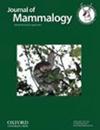人工光对太平洋袋鼠觅食行为的影响
IF 1.6
3区 生物学
Q2 ZOOLOGY
引用次数: 0
摘要
越来越多的人认识到,夜间人工照明是导致栖息地退化的一个原因,也是对野生动物物种保护的一个威胁。我们研究了美国加利福尼亚南部沿海鼠尾草灌丛中太平洋袋鼠(Dipodomys agilis)对自然光和人工光的行为反应。我们使用数字跟踪相机监测袋鼠对灌木和开阔灌木间微生境种子盘的访问。在自然光条件下,袋鼠在月圆之夜比月缺之夜更活跃,并集中在灌木下觅食。令人惊讶的是,袋鼠经常与种子盘中的其他啮齿动物互动。与离光源较远的地方相比,离人工光源较近的地方袋鼠取出的种子较少,觅食次数较少,在托盘中停留的时间也较短,尤其是在光线明亮的开放式微生境中。两次实验中第一夜和第二夜的差异表明,袋鼠了解了资源丰富的种子盘的位置,并相应地改变了它们的行为。我们的研究结果与最近的研究结果类似,都表明人工光照会抑制啮齿动物在光照最强区域的觅食活动,这也进一步证明有必要减轻城市照明对沿海鼠尾草灌丛区的影响,尤其是在城市与荒地交界处。本文章由计算机程序翻译,如有差异,请以英文原文为准。
Effects of artificial light on foraging behavior of the Pacific Kangaroo Rat (Dipodomys agilis)
Artificial light at night is increasingly recognized as a cause of habitat degradation, and as a conservation threat to wildlife species. We studied the behavioral response of Pacific kangaroo rats (Dipodomys agilis) to natural and artificial light in coastal sage scrub in southern California, United States. We used digital trail cameras to monitor visits to seed trays in shrub and open, intershrub microhabitats. Under natural-light conditions, kangaroo rats were more active on full- than new-moon nights, and concentrated foraging beneath shrubs. Surprisingly, kangaroo rats frequently interacted with other rodents in seed trays. Near to an artificial light source, kangaroo rats removed fewer seeds, had fewer foraging bouts, and spent less time in trays—especially in brightly lit open microhabitats—compared to distances farther from the light. Differences between the first and second nights of trials during both experiments suggested that kangaroo rats learned locations of resource-rich seed trays and modified their behavior accordingly. Our results are similar to recent studies showing that artificial light depresses foraging activity of rodents in the areas of highest illumination, and adds to evidence of the need to mitigate impacts of urban lighting in fragments of coastal sage scrub, especially along the urban–wildland interface.
求助全文
通过发布文献求助,成功后即可免费获取论文全文。
去求助
来源期刊

Journal of Mammalogy
生物-动物学
CiteScore
3.30
自引率
5.90%
发文量
106
审稿时长
4-8 weeks
期刊介绍:
Papers are published on mammalian behavior, conservation, ecology, genetics, morphology, physiology, and taxonomy.
 求助内容:
求助内容: 应助结果提醒方式:
应助结果提醒方式:


